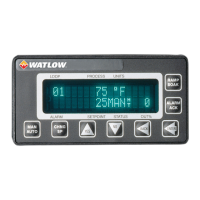CLS200 Series User’s Guide
Chapter 3: Using CLS200
62
Alarm Type: Control or Alarm
You can configure each process alarm as either a control or alarm.
• Alarm configuration provides traditional alarm functionality: The operator must acknowledge
the alarm message on the controller display, a latching global alarm is activated, and the
alarm can activate a user-specified, non-latching alarm output.
• Control configuration provides on/off control output using the alarm setpoint. For example,
you could configure a high deviation alarm to turn on a fan. The alarm activates a user-
specified non-latching output. Alarm messages do not have to be acknowledged, and the
global alarm is not activated.
High and Low Process Alarms
A high process alarm occurs if the process variable rises above a user-specified value. A low
process alarm occurs if the process variable drops below a separate user-specified value.
See Figure 3.9.
Enter the alarm high and low process setpoints at the HI PROC ALARM SETPT and LO PROC
ALARM SETPT parameters in the SETUP LOOP ALARMS menu.
Setpoint
High process alarm set point
Low process alarm
setpoint
}
Deadband
High process alarm on
High process alarm off
Low process alarm on
Low process alarm off
High deviation
alarm off
High deviation
alarm on
Low deviation
alarm off
Low deviation
alarm on
Setpoint + Deviation alarm value
Setpoint - Deviation alarm value
}
Deadband
}
Deadband
}
Deadband
Figure 3.9 — Activation and Deactivation of Process Alarms
Deviation Alarms
A deviation alarm occurs if the process deviates from setpoint by more than a user-specified
amount. (See Figure 3.9.) Set the deviation with the DEV ALARM VALUE parameter in the SETUP
LOOP ALARMS menu.
Upon power up or when the setpoint changes, the behavior of the deviation alarms depends upon
the alarm function:
• If the alarm type parameter is set to ALARM, then deviation alarms do not activate until the
after the process variable has first come within the deviation alarm band. This prevents
nuisance alarms.
• If the alarm type parameter is set to CONTROL, then the deviation output switches on
whenever the setpoint and process variable differ by more than the deviation setting,
regardless of whether the process variable has been within the deviation band. This allows
you to use boost control upon power up and setpoint changes.

